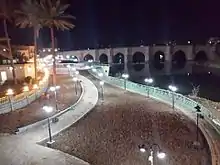Alwand River
The Alwand or Halwan River (Arabic: نهر حلوان, Kurdish: Çemê Elwen ,ڕووباری ئەڵوەن, Persian: رود الوند) is a river in eastern Iraq and western Iran. It rises in the Zagros Mountains in Iran.[1]

The river flows west from the mountains to the city of Qasr-e Shirin, where it turns south and crosses the border with Iraq. It then divides the city of Khanaqin in two parts. It has played a significant role in land cultivation and in establishment of a strong rural society in the area, and is considered by the people of Khanaqin as a symbol for their unity and Kurdish identity.
The river joins the Diyala River at Zengabadh.[1][2]
Name
According to Vladimir Minorsky, the name "Alwand" is related to the name of the historical city of Hulwan, which lay on the river near the present-day city of Sarpol-e Zahab.[3]: 80
Geography
The Alwand basin is located on the western side of the Zagros and covers an area of about 2,700 km2.[2]: 787–8 The climate of this region is semiarid to Mediterranean, with cool winters and dry summers.[2]: 788 It receives an average of about 530 mm of rainfall per year.[2]: 788 The region is characterized by karst terrain, and there are about 35 karst springs in the Alwand basin (12 major and 23 minor).[2]: 789
Geology
The Alwand basin features seven main anticlines, which are separated from each other by synclines.[2]: 789 About 36% of the basin is made up of carbonate formations, primarily the Asmari Formation.[2]: 789 The Asmari Formation, which makes up the main body of the anticlines, consists of Tertiary dolomitic limestone and dolomite.[2]: 789 Above it lie layers of the marl-and-sandstone Aghajari Formation or the gypsum-and-marl Gachasaran Formation.[2]: 789 Below it is the Cretaceous Pabdeh-Gurpi Formation, which consists of marl and shale.[2]: 789 Another carbonate formation, the Cretaceous Ilam Formation, is made of limestone and is only exposed in the Patagh anticline.[2]: 789 The Asmari Formation, confined beneath the impermeable Aghajari and Gachasaran Formations, is the main aquifer in the Alwand basin.[2]: 789
See also
References
- Houtsma, M. Th (1993). First Encyclopaedia of Islam 1913-1936. p. 807. ISBN 9004097902.
- Karimi, Haji; Raeisi, Ezzat; Bakalowicz, Michel (2005). "Characterising the main karst aquifers of the Alvand basin, northwest of Zagros, Iran, by a hydrogeochemical approach". Hydrogeology Journal. 13 (5): 787–99. doi:10.1007/s10040-004-0350-4. Retrieved 20 October 2022.
- Minorsky, Vladimir (1943). "The Gūrān". Bulletin of the School of Oriental and African Studies, University of London. 11 (1): 75–103. Retrieved 18 October 2022.